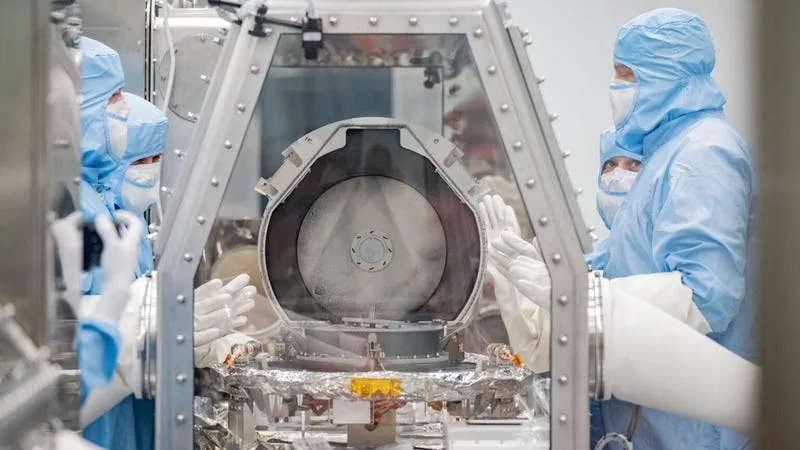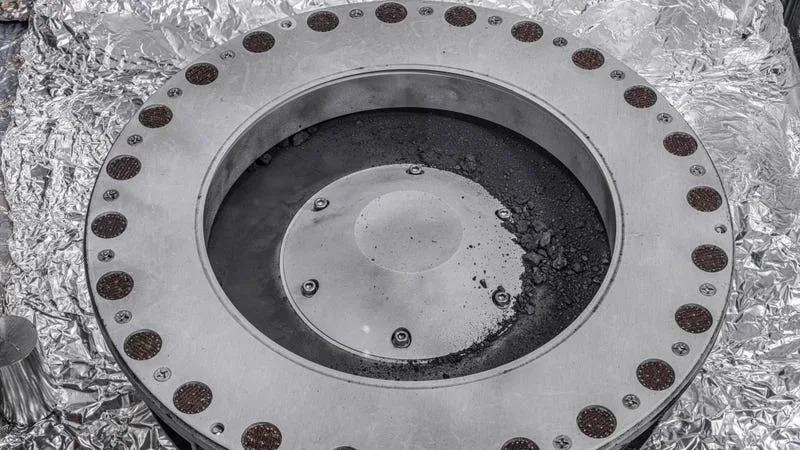It's Been 2 Months. Why Can't NASA Open the Asteroid Sample Container?
Passant Rabie
Fri, December 15, 2023

NASA curation team members along with Lockheed Martin recovery specialists removing the canister lid.
In September, fragments of a near-Earth asteroid were carefully dropped off in the Utah desert. The space rocks hold clues to the origin of the solar system and can possibly answer crucial questions about how our planet came to be—if only we can get to them first.
NASA has been struggling to open the canister containing rocks and dust collected from asteroid Bennu ever since the container landed on Earth. The space agency now anticipates that the asteroid sample canister will be opened sometime in early 2024, as engineers fashion new tools to help crank it open while still preserving the pristine rocks.
The curation team for the OSIRIS-REx mission has been having trouble opening up TAGSAM, which is being carefully handled by members of the team through a specialized glovebox under the flow of nitrogen to prevent contamination. Two of the 35 fasteners on the TAGSAM head could not be removed with the current tools approved for use in the OSIRIS-REx glovebox, preventing them from extracting the sample inside.
Fri, December 15, 2023

NASA curation team members along with Lockheed Martin recovery specialists removing the canister lid.
In September, fragments of a near-Earth asteroid were carefully dropped off in the Utah desert. The space rocks hold clues to the origin of the solar system and can possibly answer crucial questions about how our planet came to be—if only we can get to them first.
NASA has been struggling to open the canister containing rocks and dust collected from asteroid Bennu ever since the container landed on Earth. The space agency now anticipates that the asteroid sample canister will be opened sometime in early 2024, as engineers fashion new tools to help crank it open while still preserving the pristine rocks.
The curation team for the OSIRIS-REx mission has been having trouble opening up TAGSAM, which is being carefully handled by members of the team through a specialized glovebox under the flow of nitrogen to prevent contamination. Two of the 35 fasteners on the TAGSAM head could not be removed with the current tools approved for use in the OSIRIS-REx glovebox, preventing them from extracting the sample inside.

Debris from asteroid Bennu on the outside of the OSIRIS-REx sample collector.
The team did manage to collect some material from outside the TAGSAM head. When the aluminum lid to the sample canister was first removed, team members found black dust and debris on the avionics deck of the canister. They also removed some of the material from inside the canister with tweezers or a scoop while holding down the TAGSAM head’s mylar flap.
The extra bits collected so far have exceeded NASA’s goal of collecting 60 grams from the surface of Bennu, so the space agency already has material to work with. In October, NASA gave the public a first look at the asteroid samples that had been collected so far. The total amount of the asteroid sample is an estimated 8.8 ounces of rock and dust (250 grams).
Even with the bonus sample outside of TAGSAM, the $1.16 billion OSIRIS-REx mission has already proven its worth. Scientists performed an early analysis of the asteroid sample and found an abundance of carbon and water molecules, supporting the theory that the building blocks of life may have made their way to Earth via asteroids. One can only imagine what more Bennu can offer once scientists get to the bulk of its sample.
Since November, NASA has stopped trying to fidget with the sample canister, but the space agency hasn’t lost hope. Instead, NASA is currently in the process of developing and testing new tools to open up the canister.
“Design, development, and testing of new tools made of contamination-compliant materials is in [the works] to safely complete sample retrieval from the TAGSAM head in the pristine glovebox,” a NASA spokesperson told Gizmodo in an email. “Depending on the timing of building and testing, we anticipate it will be opened in the first quarter of 2024.”
The TAGSAM head may be stubborn, but the space agency is also hellbent on getting those precious space rocks into the hands of scientists around the world for analysis. The priority, of course, is to extract the sample while still protecting it from Earthly contamination that could mess with the data.
Bennu is a small near-Earth asteroid that makes a close pass to Earth every six years or so. Scientists believe Bennu might have broken off from a much larger carbon-rich asteroid about 700 million to 2 billion years ago, and drifted much closer to Earth since then.
The plan is for the curation team at NASA’s Johnson Space Center to extract and weigh the sample, create an inventory of what’s inside, and distribute pieces of Bennu to international teams of scientists. Hopefully NASA will be able to crack that baby open, giving us a better chance of learning about the origins of our star system.
No comments:
Post a Comment